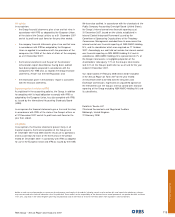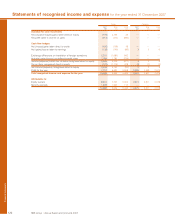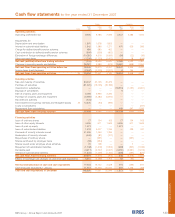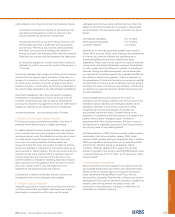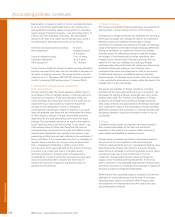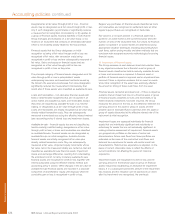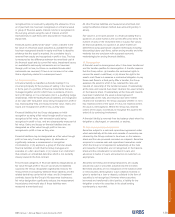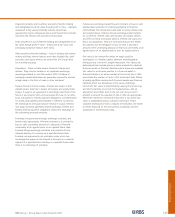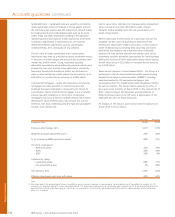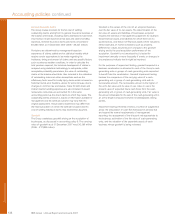RBS 2007 Annual Report Download - page 130
Download and view the complete annual report
Please find page 130 of the 2007 RBS annual report below. You can navigate through the pages in the report by either clicking on the pages listed below, or by using the keyword search tool below to find specific information within the annual report.
RBS Group • Annual Report and Accounts 2007
128
Accounting policies continued
Financial statements
Designated as at fair value through profit or loss – financial
assets may be designated as at fair value through profit or loss
only if such designation (a) eliminates or significantly reduces
a measurement or recognition inconsistency; or (b) applies to
a group of financial assets, financial liabilities or both that the
Group manages and evaluates on a fair value basis; or (c)
relates to an instrument that contains an embedded derivative
which is not evidently closely related to the host contract.
Financial assets that the Group designates on initial
recognition as being at fair value through profit or loss are
recognised at fair value, with transaction costs being
recognised in profit or loss and are subsequently measured at
fair value. Gains and losses on financial assets that are
designated as at fair value through profit or loss are
recognised in profit or loss as they arise.
The principal category of financial assets designated as at fair
value through profit or loss is policyholders’ assets
underpinning insurance and investment contracts issued by
the Group's life assurance businesses. Fair value designation
significantly reduces the measurement inconsistency that
would arise if these assets were classified as available-for-sale.
Loans and receivables – non-derivative financial assets with
fixed or determinable repayments that are not quoted in an
active market are classified as loans and receivables except
those that are classified as available-for-sale or as held-for-
trading, or designated as at fair value through profit or loss.
Loans and receivables are initially recognised at fair value plus
directly related transaction costs. They are subsequently
measured at amortised cost using the effective interest method
(see accounting policy 3 above) less any impairment losses.
Available-for-sale – financial assets that are not classified as
held-to-maturity; held-for-trading; designated as at fair value
through profit or loss; or loans and receivables are classified
as available-for-sale. Financial assets can be designated as
available-for-sale on initial recognition. Available-for-sale
financial assets are initially recognised at fair value plus
directly related transaction costs. They are subsequently
measured at fair value. Unquoted equity investments whose
fair value cannot be measured reliably are carried at cost and
classified as available-for-sale financial assets. Impairment
losses and exchange differences resulting from retranslating
the amortised cost of currency monetary available-for-sale
financial assets are recognised in profit or loss together with
interest calculated using the effective interest method (see
accounting policy 3 above). Other changes in the fair value of
available-for-sale financial assets are reported in a separate
component of shareholders’ equity until disposal, when the
cumulative gain or loss is recognised in profit or loss.
Regular way purchases of financial assets classified as loans
and receivables are recognised on settlement date; all other
regular way purchases are recognised on trade date.
Fair value for a net open position in a financial asset that is
quoted in an active market is the current bid price times the
number of units of the instrument held. Fair values for financial
assets not quoted in an active market are determined using
appropriate valuation techniques including discounting future
cash flows, option pricing models and other methods that are
consistent with accepted economic methodologies for pricing
financial assets.
13. Impairment of financial assets
The Group assesses at each balance sheet date whether there
is any objective evidence that a financial asset or group of
financial assets classified as held-to-maturity, available-for-sale
or loans and receivables is impaired. A financial asset or
portfolio of financial assets is impaired and an impairment loss
incurred if there is objective evidence that an event or events
since initial recognition of the asset have adversely affected
the amount or timing of future cash flows from the asset.
Financial assets carried at amortised cost – if there is objective
evidence that an impairment loss on a financial asset or group
of financial assets classified as loans and receivables or as
held-to-maturity investments has been incurred, the Group
measures the amount of the loss as the difference between the
carrying amount of the asset or group of assets and the
present value of estimated future cash flows from the asset or
group of assets discounted at the effective interest rate of the
instrument at initial recognition.
Impairment losses are assessed individually for financial
assets that are individually significant and individually or
collectively for assets that are not individually significant. In
making collective assessment of impairment, financial assets
are grouped into portfolios on the basis of similar risk
characteristics. Future cash flows from these portfolios are
estimated on the basis of the contractual cash flows and
historical loss experience for assets with similar credit risk
characteristics. Historical loss experience is adjusted, on the
basis of current observable data, to reflect the effects of
current conditions not affecting the period of historical
experience.
Impairment losses are recognised in profit or loss and the
carrying amount of the financial asset or group of financial
assets reduced by establishing an allowance for impairment
losses. If in a subsequent period the amount of the impairment
loss reduces and the reduction can be ascribed to an event
after the impairment was recognised, the previously



